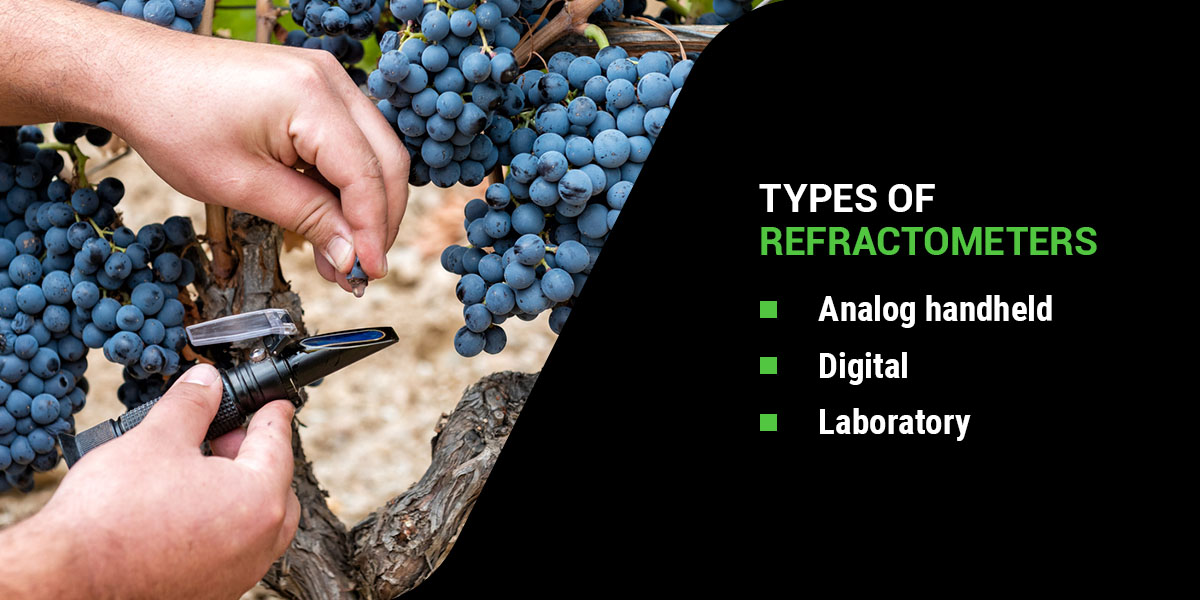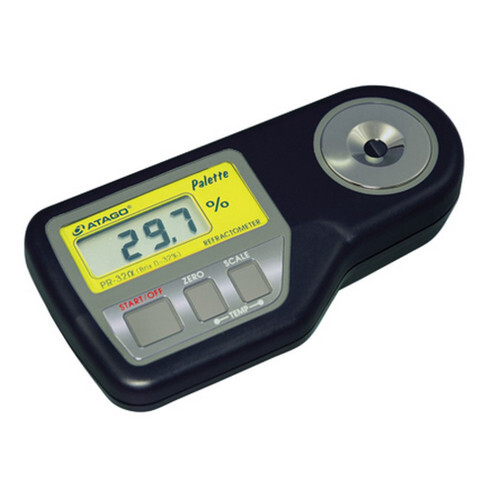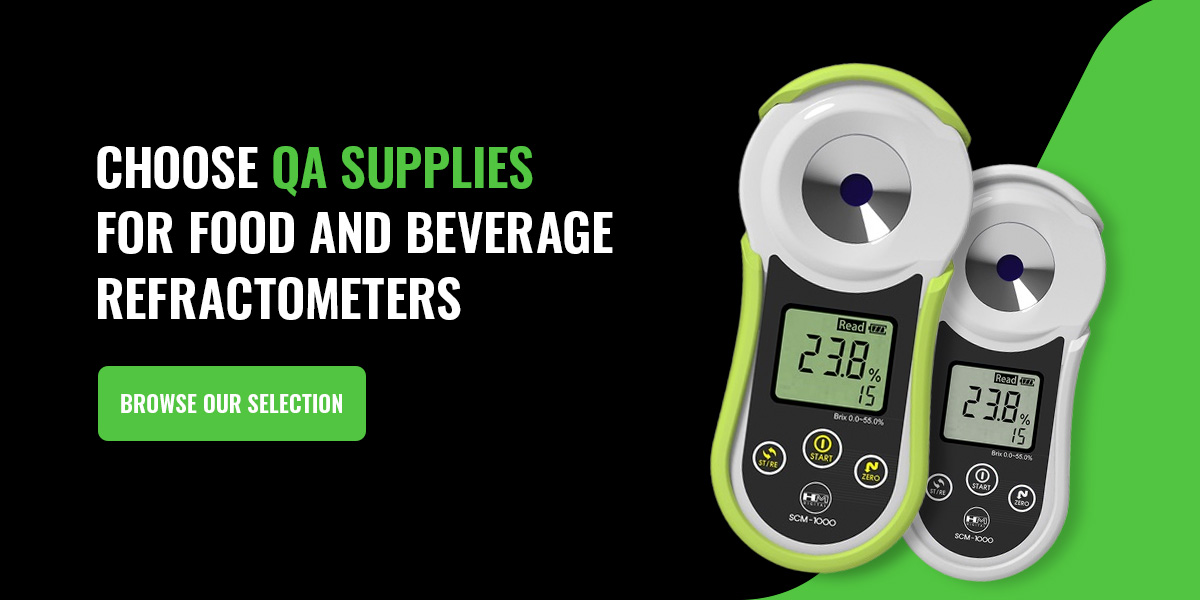Refractometer Uses in the Food and Beverage Industry
Mar 6th 2023
- What Does a Refractometer Measure in Food?
- What Kind of Food and Beverages Are Refractometers Used For?
- How Does the Food and Beverage Industry Use Refractometers?
- Types of Refractometers
- How Do You Use a Refractometer for Food and Beverages?
- Choose QA Supplies for Food and Beverage Refractometers
Refractometers have become a staple in the food and beverage industry, ensuring the quality of products before they are completed and sent out to consumers. The right refractometer will quickly and accurately read your sample's soluble solids content to help you ensure consistency in your products.
The food and beverage industry uses refractometers formeasuring the soluble solids content (SSC) in a solution, including sugar, salt, protein and acids. Understanding the content of a food or beverage can help improve its quality and consistency, ensuring correct composition in each batch.
Refractometers pass light through a food or beverage sample and measure the angle of refraction. Once the light passes through the reader, it measures the refraction — the angle that the light bends — and gives you the reading.
What Kind of Food and Beverages Are Refractometers Used For?
Any products in the food and beverage industry with strict control standards to ensure product quality and safety can benefit from refractometer use. Some examples of foods and beverages that use refractometers for testing include:
- Milk
- Tea
- Juices
- Juice concentrates
- Candy
- Starch
- Soybean oils
- Seed oils
- Syrups
- Fruit products
- Vegetable products
- Dairy products
- Extracts
- Sodas and soft drinks
- Jellies
- Jams
- Soups
Refractometers provide convenience, cleanliness and accuracy, with strict monitoring essential to production output and safety. They allow areas with strict quality standards, like winemaking, to produce food and beverages that follow those standards batch after batch.
In addition to maintaining product consistency, refractometers can test fruit ripeness. Testing some of a fruit's juice with a refractometer will tell you how ripe the fruit is as it reads the juice composition. Any food or beverage that needs its SSC standardized or tested will need a refractometer.
Refractometer Uses in the Food and Beverage Industry
Refractometry in food analysis helps maintain quality standards. Checking a food or beverage's SSC allows companies to ensure their products' safety, taste and consistency before they reach consumers. With this testing, producers have more reliable information on the makeup of the products they ship.
In addition to quality control, the food and beverage industry uses refractometers to:
- Measure sugar content: Companies use a Brix meter for sugar to test dozens of foods and beverages. Brix is the measurement used for the sugar content in a food or beverage — one degree Brix equals 1% sucrose. The more sugar in a food or beverage, the higher the Brix refractometer reads.
- Measure protein, salt and moisture content: Other foods and beverages may require refractometers for measuring protein, salt or moisture content. Measuring the salt content of cheeses allows producers to create consistent, delicious products year-round. Other refractometers can measure the moisture content of honey and the water content of milk.
- Test fruit ripeness: Refractometers enable companies to evaluate fruit ripeness before large-scale harvesting. Testing fruit ripeness before harvesting is critical to maintaining the flavor and safety of fruit. When paired with measuring dry matter, refractometry lets companies analyze produce's quality and maturity with exceptional accuracy.
The more producers know about the makeup of their products, the better their products will be and the less waste they'll have.

Types of Refractometers
There are several different types of refractometers, each with its own specialty. The right kind of refractometer for you will depend on your needs. Let's go over the different refractometer types to help you select the best one for your food and beverage checks:
- Analog handheld refractometer: A traditional analog handheld refractometer has no batteries and is small for easy carrying. With excellent water resistance and quality durability, traditional handheld refractometers are a staple for taking measurements from everything from soda to fruit to soups.
- Digital refractometer: Digital refractometers are an excellent advancement in food and beverage refractometry, such as the Atago PR-32 Alpha Refractometer. While not always as portable as traditional refractometers, they're more accurate and come with automatic temperature compensation. Handheld digital refractometers are more convenient to use, as they contain their own light source and photodiodes, which read the measurement and display the result on a screen.
- Laboratory: Also called Abbe refractors, these devices can measure both solid and liquid samples. These more advanced instruments read a product's SSC in a lab setting.
The food and beverage industry uses analog handheld, digital and laboratory refractometers. While laboratory refractometers can measure many types of products, the industry often prefers handheld refractometers. Their portability and durability make them ideal for measuring the different contents of food and beverages as you move through your facility.
Digital refractometers with automatic temperature control can break down the content of solutions, giving producers more control over their products than ever. Product consistency and consumer safety are vital in the food and beverage industry. Without specialized refractometers ensuring product readiness, makeup and quality, producers would have a significantly harder time safely testing their products.
How Do You Use a Refractometer for Food and Beverages?
While there are a few differences between the two refractometer types, using an analog or digital refractometer is relatively simple. Let's go over how to use them to help you successfully take food and beverage readings.
Analog Handheld
To use a traditional analog handheld refractometer:
- Use a pipette to place a liquid sample on the measuring space underneath the protective flap.
- Look through the eyepiece on the end and activate the illuminator if your refractometer has one.
- Read the scale at the point where light and dark meet to obtain your reading.
Digital
Since digital refractometers measure for you, you don't have to look through an eyepiece. Here's how to use one:
- Turn the power on and zero-set the refractometer if it's your first use.
- If your refractometer has scale options, select the scale you wish to use.
- Once you've chosen a scale, use an applicator or pipette to place your sample on the measuring surface.
- Wait 30 seconds or the amount of time listed in your manufacturer's instructions.
- The refractometer will display the reading.
Choose QA Supplies for Food and Beverage Refractometers
Checking products' soluble solids content is essential for food and beverage producers. With accurate, durable instruments, you can feel confident in your products' quality, consistency and safety. At QA supplies, we carry a range of high-quality digital and handheld refractometers to ensure you can meet and exceed product standards at your facility. Shop our refractometers and related products online today!



